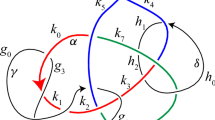Abstract
The Alexander polynomial in several variables is defined for links in three-dimensional homology spheres, in particular, in the Poincaré sphere: the intersection of the surface \(S=\{(z_1,z_2,z_3)\in {\mathbb {C}}^3: z_1^5+z_2^3+z_3^2=0\}\) with the 5-dimensional sphere \({\mathbb {S}}_{\varepsilon }^5=\{(z_1,z_2,z_3)\in {\mathbb {C}}^3: \vert z_1\vert ^2+\vert z_2\vert ^2+\vert z_3\vert ^2=\varepsilon ^2\}\). An algebraic link in the Poincaré sphere is the intersection of a germ of a complex analytic curve in (S, 0) with the sphere \({\mathbb S}^5_\varepsilon \) of radius \(\varepsilon \) small enough. Here we discuss to which extent the Alexander polynomial in several variables of an algebraic link in the Poincaré sphere determines the topology of the link. We show that, if the strict transform of a curve in (S, 0) does not intersect the component of the exceptional divisor corresponding to the end of the longest tail in the corresponding \(E_8\)-diagram, then its Alexander polynomial determines the combinatorial type of the minimal resolution of the curve and therefore the topology of the corresponding link. The Alexander polynomial of an algebraic link in the Poincaré sphere is determined by the Poincaré series of the filtration defined by the corresponding curve valuations. (They coincide with each other for a reducible curve singularity and differ by the factor \((1-t)\) for an irreducible one.) We show that, under conditions similar to those for curves, the Poincaré series of a collection of divisorial valuations determines the combinatorial type of the minimal resolution of the collection.










Similar content being viewed by others
References
A’Campo, N.: La fonction zeta d’une monodromie. Comment. Math. Helv. 50, 233–248 (1975)
Brieskorn, E.: Rationale Singularitäten komplexer Flächen. Invent. Math. 4(5), 336–358 (1968)
Campillo, A., Delgado, F., Gusein-Zade, S.M.: The Alexander polynomial of a plane curve singularity via the ring of functions on it. Duke Math. J. 117(1), 125–156 (2003)
Campillo, A., Delgado, F., Gusein-Zade, S.M.: Poincaré series of a rational surface singularity. Invent. Math. 155(1), 41–53 (2004)
Campillo, A., Delgado, F., Gusein-Zade, S.M.: Poincaré series of curves on rational surface singularities. Comment. Math. Helv. 80(1), 95–102 (2005)
Campillo, A., Delgado, F., Gusein-Zade, S.M.: The Poincaré series of divisorial valuations in the plane defines the topology of the set of divisors. Funct. Anal. Other Math. 3(1), 39–46 (2010)
Campillo, A., Delgado, F., Gusein-Zade, S.M.: On the topological type of a set of plane valuations with symmetries. Math. Nachr. 290(13), 1925–1938 (2017)
Campillo, A., Delgado, F., Kiyek, K.: Gorenstein property and symmetry for one-dimensional local Cohen-Macaulay rings. Manuscripta Math. 83(3–4), 405–423 (1994)
Delgado, F., Gusein-Zade, S.M.: Poincaré series for several plane divisorial valuations. Proc. Edinb. Math. Soc. 46(2), 501–509 (2003)
Eisenbud, D., Neumann, W.: Three-Dimensional Link Theory and Invariants of Plane Curve Singularities. Annals of Mathematics Studies, vol. 110. Princeton University Press, Princeton (1985)
Gonzalez-Sprinberg, G., Lejeune-Jalabert, M.: Families of smooth curves on surface singularities and wedges. Ann. Polon. Math. 67(2), 179–190 (1997)
Mumford, D.: The topology of normal singularities of an algebraic surface and a criterion for simplicity. Publ. Math. de l’IHÉS 9, 5–22 (1961)
Pe Pereira, M.: Nash problem for quotient surface singularities. J. Lond. Math. Soc. 87(1), 177–203 (2013)
Wall, C.T.C.: Singular points of plane curves. London Mathematical Society Student Texts no.63. Cambridge University Press, Cambridge (2004)
Yamamoto, M.: Classification of isolated algebraic singularities by their Alexander polynomials. Topology 23(3), 277–287 (1984)
Author information
Authors and Affiliations
Corresponding author
Additional information
Publisher's Note
Springer Nature remains neutral with regard to jurisdictional claims in published maps and institutional affiliations.
A. Campillo and F. Delgado were supported by the Grant MTM2015-65764-C3-1-P (with the help of FEDER Program).
S. M. Gusein-Zade (Sects. 2, 4, 6) was supported by the Grant 16-11-10018 of the Russian Science Foundation.
Rights and permissions
About this article
Cite this article
Campillo, A., Delgado, F. & Gusein-Zade, S.M. Are algebraic links in the Poincaré sphere determined by their Alexander polynomials?. Math. Z. 294, 593–613 (2020). https://doi.org/10.1007/s00209-019-02282-0
Received:
Accepted:
Published:
Issue Date:
DOI: https://doi.org/10.1007/s00209-019-02282-0




